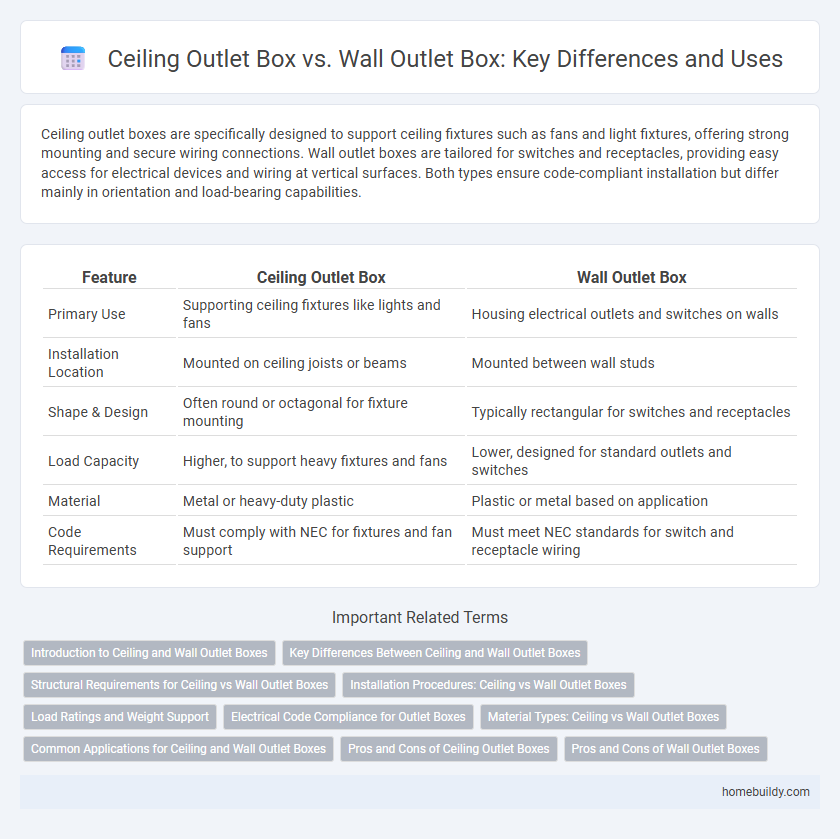Ceiling outlet boxes are specifically designed to support ceiling fixtures such as fans and light fixtures, offering strong mounting and secure wiring connections. Wall outlet boxes are tailored for switches and receptacles, providing easy access for electrical devices and wiring at vertical surfaces. Both types ensure code-compliant installation but differ mainly in orientation and load-bearing capabilities.
Table of Comparison
| Feature | Ceiling Outlet Box | Wall Outlet Box |
|---|---|---|
| Primary Use | Supporting ceiling fixtures like lights and fans | Housing electrical outlets and switches on walls |
| Installation Location | Mounted on ceiling joists or beams | Mounted between wall studs |
| Shape & Design | Often round or octagonal for fixture mounting | Typically rectangular for switches and receptacles |
| Load Capacity | Higher, to support heavy fixtures and fans | Lower, designed for standard outlets and switches |
| Material | Metal or heavy-duty plastic | Plastic or metal based on application |
| Code Requirements | Must comply with NEC for fixtures and fan support | Must meet NEC standards for switch and receptacle wiring |
Introduction to Ceiling and Wall Outlet Boxes
Ceiling outlet boxes are designed to securely hold fixtures like ceiling fans and light fixtures, providing strong support for overhead installations. Wall outlet boxes are typically used to house switches, receptacles, and other electrical devices at convenient heights along walls. Both types of boxes are essential for safe electrical wiring, meeting specific installation requirements based on their location and purpose.
Key Differences Between Ceiling and Wall Outlet Boxes
Ceiling outlet boxes are designed primarily to support lighting fixtures and ceiling fans, featuring deeper and rounder shapes to accommodate wiring and hanging hardware, while wall outlet boxes are typically shallower with rectangular or square shapes for switches and receptacles. Ceiling boxes often have stronger mounting brackets or braces to bear the weight of fixtures, unlike wall boxes, which are secured to studs for stability without weight support. Wiring capacity also differs, with ceiling boxes allowing more space for complex electrical connections needed for lighting circuits versus simpler setups in wall boxes.
Structural Requirements for Ceiling vs Wall Outlet Boxes
Ceiling outlet boxes require enhanced structural support to accommodate the weight of light fixtures and ceiling fans, often necessitating reinforced framing or mounting brackets. Wall outlet boxes, in contrast, typically support lighter devices like switches or receptacles and rely on standard stud mounting without additional reinforcement. Proper installation of both ensures compliance with electrical codes and maintains the integrity of the building structure.
Installation Procedures: Ceiling vs Wall Outlet Boxes
Ceiling outlet box installation requires secure mounting to joists or cross braces, with careful alignment for light fixtures or fans, ensuring proper support and wiring access through the ceiling structure. Wall outlet boxes typically install by attaching to wall studs or using old-work boxes for retrofit applications, with emphasis on maintaining flush alignment with drywall and accommodating switch or receptacle devices. Both types demand adherence to electrical codes for grounding, wire clamps, and box fill capacity to ensure safety and functionality.
Load Ratings and Weight Support
Ceiling outlet boxes typically have higher load ratings and enhanced weight support compared to wall outlet boxes, designed to safely hold heavy fixtures like ceiling fans and chandeliers. Wall outlet boxes are generally rated for lighter loads, suitable for switches, receptacles, and lighter lighting fixtures. Selecting the correct outlet box based on load capacity ensures compliance with electrical codes and prevents structural damage or fixture failure.
Electrical Code Compliance for Outlet Boxes
Ceiling outlet boxes and wall outlet boxes must both comply with National Electrical Code (NEC) guidelines to ensure safety and functionality. Ceiling boxes are specifically designed to support fixtures like ceiling fans or light fixtures, requiring secure mounting and appropriate weight ratings as per NEC Article 314. Wall outlet boxes must meet depth and size specifications to safely accommodate switches and receptacles, ensuring proper wiring space and grounding as outlined in NEC Article 314.16.
Material Types: Ceiling vs Wall Outlet Boxes
Ceiling outlet boxes are typically made from durable materials such as steel or galvanized metal to support the weight of light fixtures and ceiling fans, ensuring safety and stability. Wall outlet boxes often use plastic or PVC materials, which provide insulation and resistance to moisture, suitable for housing electrical outlets and switches. The choice of material for ceiling versus wall outlet boxes directly impacts their application, with ceiling boxes prioritizing strength and wall boxes emphasizing electrical safety and ease of installation.
Common Applications for Ceiling and Wall Outlet Boxes
Ceiling outlet boxes are commonly used for installing light fixtures, ceiling fans, and smoke detectors, providing secure mounting and electrical connections overhead. Wall outlet boxes typically house switches, receptacles, and data ports, ensuring accessible power and communication points at convenient heights. Both types are designed to meet specific code requirements and support electrical device installation in residential and commercial buildings.
Pros and Cons of Ceiling Outlet Boxes
Ceiling outlet boxes offer the advantage of supporting heavy fixtures like ceiling fans and chandeliers, providing secure mounting points and easy access for wiring. However, they can be more challenging to install compared to wall outlet boxes, often requiring additional reinforcement and precise positioning in ceiling joists. Their design also limits the type of devices that can be installed, making them less versatile than wall outlet boxes for general electrical needs.
Pros and Cons of Wall Outlet Boxes
Wall outlet boxes offer easier access for wiring and device installation, making them ideal for switches and receptacles in living spaces. They allow for flexible mounting options and better cable management within wall cavities, but can be limited by wall thickness and structural obstructions. Unlike ceiling outlet boxes, wall boxes are less suitable for heavy fixtures, reducing their use in overhead lighting installations.
Ceiling outlet box vs Wall outlet box Infographic

 homebuildy.com
homebuildy.com